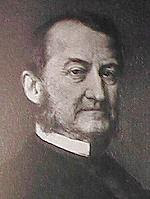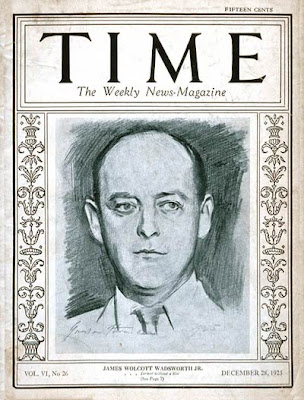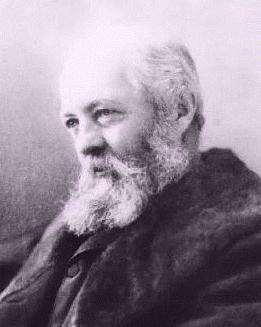Finally got the genealogy site up and running. Next task is to upload the photos and stories and add more to the front page.
www.fiske-bigelow.com
That's pretty much the reason why I haven't blogged in what seems like forever. I have almost 13000 people in my family tree, 200+ photos and lots of stories.
Friday, August 15, 2008
Friday, June 20, 2008
William R Travers

William Riggin Travers (July, 1819 – March 19, 1887) was an American lawyer who made a fortune on Wall Street. Along with John Hunter, in 1863 he founded Saratoga Race Course and served as its first president. Saratoga's Travers Stakes is named in his honor and is the oldest major Thoroughbred horse race in the United States. In 1884, William Travers became one of the backers of the Sheepshead Bay Race Track on Coney Island.
Travers was a partner in Annieswood Stable with John Hunter and George Osgood. The operation had considerable success both in racing runners and with breeding at their Annieswood Stud farm in Westchester County, New York. Their horse Kentucky won the first running of the Travers Stakes in 1864. One of their most famous horses was Alarm, considered one of the best sprint race horses in American Thoroughbred horse racing history.
Travers was a long-time president of the New York Athletic Club. On January 13, 1887 the club purchased Hogg Island in Long Island Sound and Pelham, New York shoreline from the estate of John Hunter and renamed it Travers Island in his honor.
A well-known cosmopolite and high liver, Travers was a member of 27 private clubs, according to Cleveland Amory in his book Who Killed Society?
William R. Travers married Maria Louisa, the fourth daughter of Reverdy Johnson. They had nine children. One of their five daughters, Matilda, married the painter Walter Gay and moved to Paris, France in 1876 where she remained until her death in 1943
Lineage: William R Travers 1819 was father to Louisa Travers aka Maria Louisa Travers 1848 who married James W Wadsworth 1877, James Wolcott Wadsworth 1846, James Samuel Wadsworth 1807, James Wadsworth 1768, John Noyes Wadsworth 1732, James Wadsworth 1677, John Wadsworth 1630, William Wadsworth 1594, William Wadsworth. Hannah Wadsworth 1750 was the 3rd great granddaughter of WW 1550. She married John Bigelow 1739
Wednesday, May 21, 2008
Reverdy Johnson - Senator, US Attorney General


From 1845 to 1849, he represented Maryland in the United States Senate as a Whig, and from March 1849 until July 1850 he was Attorney General of the United States under President Zachary Taylor. He resigned that position when Millard Fillmore took office.
A conservative Democrat, he supported Stephen A. Douglas in the presidential election of 1856. He represented the slave-owning defendant in the infamous 1857 case Dred Scott v. Sandford. Personally opposed to slavery and was a key figure in the effort to keep Maryland from seceding from the Union during the American Civil War.
He served as a Maryland delegate to the Peace Convention of 1861 and from 1861 to 1862 served in the Maryland House of Delegates. During this time he represented Maj. Gen. Fitz John Porter at his court-martial, arguing that Porter's distinguished record of service ought to put him beyond question. The officers on the court-martial, all handpicked by Secretary of War Edwin Stanton, voted to convict Porter of cowardice and disobedience.
After the capture of New Orleans, he was commissioned by President Abraham Lincoln to revise the decisions of the military commandant, General Benjamin F. Butler, in regard to foreign governments, and reversed all those decisions to the entire satisfaction of the administration. After the war, representing the riven points of view held by his fellow statesmen, Johnson argued for a gentler Reconstruction effort than that advocated by the Radical Republicans.
In 1863 he again took a seat in the United States Senate, serving through 1868. In 1865, he defended Mary Surratt before a military tribunal. Surratt was convicted and executed for plotting and aiding Lincoln's assassination. In 1866, he was a delegate to the National Union Convention which attempted to build support for President Johnson. Senator Johnson's report on the proceedings of the convention was entered into the record of President Johnson's impeachment trial. In 1868 he was appointed minister to the United Kingdom and soon after his arrival in England negotiated the Johnson-Clarendon Treaty for the settlement of disputes arising out of the Civil War; this, however, the Senate refused to ratify, and he returned home on the accession of General Ulysses S. Grant to the presidency. Again resuming his legal practice, he was engaged by the government in the prosecution of cases against the Ku Klux Klan as well as work compiling the reports of the decisions of the Maryland Court of Appeals.
In 1876, he fell from a balcony at the Governor's Mansion in Annapolis and was killed instantly. He is buried in Greenmount Cemetery at Baltimore. Prior to his death, Johnson had been the last surviving member of the Taylor Cabinet.
Lineage Reverdy Johnson 1796 was the father of Louise Johnson 1827 who married William Riggin Travers 1819. William R Travers 1819 was father to Louisa Travers aka Maria Louisa Travers 1848 who married James W Wadsworth 1877, James Wolcott Wadsworth 1846, James Samuel Wadsworth 1807, James Wadsworth 1768, John Noyes Wadsworth 1732, James Wadsworth 1677, John Wadsworth 1630, William Wadsworth 1594, William Wadsworth. Hannah Wadsworth 1750 was the 3rd great granddaughter of William Wadsworth 1550. She married John Bigelow 1739
Friday, May 16, 2008
James Wolcott Wadsworth Jr

James Wolcott Wadsworth Jr. (August 12, 1877 - June 21, 1952) was a U.S. Republican politician, grandson of General Wadsworth. A member of Skull and Bones, he graduated from Yale in 1898, and immediately entered the live-stock and farming business in which his father was interested both in New York and Texas.[1]He became active early in Republican politics, being elected to the New York State Assembly in 1905 (when 28 years old) and serving continuously until 1910. He was speaker of the Assembly from 1906 to 1910. He served in the U.S. Senate from 1915 until 1927, and as a United States Congressman from 1933 until 1951.
Wadsworth was a firm proponent of individual rights and feared what he considered the threat of federal intervention into the private lives of Americans. He believed that the only purpose of the Constitution was to and limit the powers of government and to protect the rights of citizens. For this reason, he voted against the Eighteenth Amendment when it was before the Senate. Before it went into effect, Wadsworth predicted that prohibition would result in widespread violations and contempt for law and the Constitution.
By the mid-1920s, Wadsworth was one of a handful of congressmen who spoke out forcefully and frequently against Prohibition. He was especially concerned that citizens could be prosecuted by both state and federal officials for a single violation of prohibition law. This seemed to him to constitute double jeopardy, inconsistent with the spirit if not the letter of the Constitution.
Lineage: James Wolcott Wadsworth Jr. 1877, James Wolcott Wadsworth 1846, James Samuel Wadsworth 1807, James Wadsworth 1768, John Noyes Wadsworth 1732, James Wadsworth 1677, John Wadsworth 1630, William Wadsworth 1594, William Wadsworth 1550. William Wadsworth 1550 was the 3x great grandfather to Hannah Wadsworth 1750 who married John Bigelow 1739.
Thursday, May 15, 2008
James Samuel Wadsworth

Wadsworth was born in Geneseo, New York, to wealthy parents. His father was the owner of one of the largest portfolios of cultivated land in the state and young Wadsworth was groomed to fulfill the responsibilities he would inherit. He attended both Harvard University and Yale University, studied law, and was admitted to the bar, but had no intention of practicing. He spent the majority of his life managing his family's estate. Out of a sense of noblesse oblige, he became a philanthropist and entered politics, first as a Democrat, but then as one of the organizers of the Free Soil Party, which joined the Republican Party in 1856. In 1861, he was a member of the Washington peace conference, an unofficial gathering of Northern and Southern moderates attempted to avert war. But after war became inevitable, he considered it his duty to volunteer.
Despite his complete lack of military experience, at the outbreak of the Civil War Wadsworth was commissioned a major general of the New York state militia. He served as a civilian volunteer aide-de-camp to Maj. Gen. Irvin McDowell at the First Battle of Bull Run in July 1861. McDowell recommended him for command and, on August 9, 1861, James Wadsworth was commissioned a brigadier general of volunteers; in October, he received command of a brigade in McDowell's division of the Army of the Potomac.
From March to September 1862, Wadsworth commanded the Military District of Washington. During the preparations for Maj. Gen. George B. McClellan's Peninsula Campaign, Wadsworth complained to President Abraham Lincoln that he had insufficient troops to defend the capital due to McClellan's plan to take a large number of them with him to the Virginia Peninsula. Lincoln countermanded McClellan's plan and restored a full corps to the Washington defenses, generating ill feelings between McClellan and Wadsworth. Seeing no prospects for serving in McClellan's army, Wadsworth allowed his name to be put into nomination for governor of New York against antiwar Democrat Horatio Seymour, but he declined to leave active duty to campaign and lost the election.
After McClellan left the Army of the Potomac, and after the serious Union defeat at the Battle of Fredericksburg, Wadsworth was appointed commander of the 1st Division, I Corps, replacing Maj. Gen. George G. Meade, who had been promoted to command the V Corps. He was a dashing division commander, trim and vigorous at 56 years old, snow white hair with large white mutton chop sideburns, brandishing an officer's saber from the American Revolutionary War. He was widely admired in his new division because he spent considerable effort looking after the welfare of his men, making sure that their rations and housing were adequate. They were also impressed that he was so devoted to the Union cause that he had given up a comfortable life to serve in the Army without drawing pay.
Wadsworth's division's first test in combat under his command was at the Battle of Chancellorsville in May 1863. He made a faltering start in maneuvering his men across the Rappahannock River below Fredericksburg and they ended up being only lightly engaged during the battle. His performance at the Battle of Gettysburg was much more substantial. Arriving in the vanguard of John F. Reynolds's I Corps on July 1, 1863, Wadsworth's division bore much of the brunt of the overwhelming Confederate attack that morning and afternoon. They were able to hold out against attacks from both the west and north, giving the Army of the Potomac time to bring up sufficient forces to hold the high ground south of town and eventually win the battle. But by the time the division retreated back through town to Cemetery Hill that evening, it had suffered over 50% casualties. Despite these losses, on the second day of battle, Wadsworth sent two regiments to reinforce the defense of Culp's Hill.
I Corps had been so significantly damaged at Gettysburg that, when the Army of the Potomac was reorganized in March 1864, its surviving regiments were dispersed to other corps. After an eight-month leave of absence, Wadsworth was named commander of the 4th Division, V Corps. This speaks well for his performance at Gettysburg because a number of his contemporaries were left without assignments when the army reorganized. At the start of Lt. Gen. Ulysses S. Grant's Overland Campaign, Wadsworth led his division at the Battle of the Wilderness. He was mortally wounded in the head on May 6, 1864, and captured by Confederate forces.
Wadsworth died two days later in a Confederate field hospital. He is buried in the Temple Hill Cemetery in Geneseo, New York. The day before he was wounded, he was promoted to major general of volunteers, but this appointment was withdrawn and he received instead a posthumous brevet promotion to major general as of May 6, 1864, for his service at Gettysburg and the Wilderness.
Lineage James Samuel Wadsworth 1807, James Wadsworth 1768, John Noyes Wadsworth 1732, James Wadsworth 1677, John Wadsworth 1630, William Wadsworth 1594, William Wadsworth. Hannah Wadsworth 1750 was the 3rd great granddaughter of WW 1550. She married John Bigelow 1739.
Monday, May 12, 2008
Henry Wadsworth Longfellow

Henry Wadsworth Longfellow (February 27, 1807 – March 24, 1882) was an American poet whose works include "Paul Revere's Ride", The Song of Hiawatha, and "Evangeline". He was also the first American to translate Dante Alighieri's The Divine Comedy and was one of the five members of the group known as the Fireside Poets.
Longfellow was born in Portland, Maine and studied at Bowdoin College. After spending time in Europe he became a professor at Bowdoin and, later, at Harvard College. His first major poetry collections were Voices of the Night (1839) and Ballads and Other Poems (1842). Longfellow retired from teaching in 1854 to focus on his writing, though he lived the remainder of his life in Cambridge, Massachusetts in a former headquarters of George Washington.
Longfellow predominantly wrote lyric poetry, known for its musicality, which often presented stories of mythology and legend. He became the most popular American poet of his day and also had success overseas. He has been criticized, however, for imitating European styles and writing specifically for the masses.
Lineage Henry Wadsworth Longfellow, son of Zilpah Wadsworth 1778, Brig. General Peleg Wadsworth 1748, Peleg Wadsworth 1715, John Wadsworth 1672, John Wadsworth 1638, William Wadsworth 1555. Hannah Wadsworth 1750 married John Bigelow 1739. Hannah Wadsworth was the daughter of Samuel 1716, Jonathan 1687, Joseph 1650, William 1594, William 1555.
Friday, May 9, 2008
Frederick Law Olmstead


Watertown is the smallest city to have a park designed by Frederick Law Olmsted, the celebrated landscape architect who created Central Park in New York City.
Frederick Law Olmsted (April 25, 1822 – August 28, 1903) was an American landscape designer and father of American landscape architecture, famous for designing many well-known urban parks, including Central Park and Prospect Park in New York City. Other project include the country's oldest coordinated system of public parks and parkways in Buffalo, New York, the country's oldest state park, the Niagara Reservation in Niagara Falls, New York, Mount Royal Park in Montreal, the Emerald Necklace in Boston, Massachusetts, Cherokee Park (and the entire parks and parkway system) in Louisville, Kentucky, as well as Jackson Park, Washington Park, Midway Plaisance in Chicago for the World's Columbian Exposition, Detroit's 982 acre Belle Isle park, the landscape surrounding the United States Capitol building, Piedmont Park in Atlanta, George Washington Vanderbilt II's Biltmore Estate in North Carolina, and Montebello Park in St. Catharines, Ontario
Lineage: Frederick Law Olmsted 1822, John Olmsted 1791, Benjamin Olmsted 1750, Johnathon Olmsted 1706, Capt. Aaron Olmsted brother of JO 1706 married Mary Langrell Bigelow.
Subscribe to:
Posts (Atom)